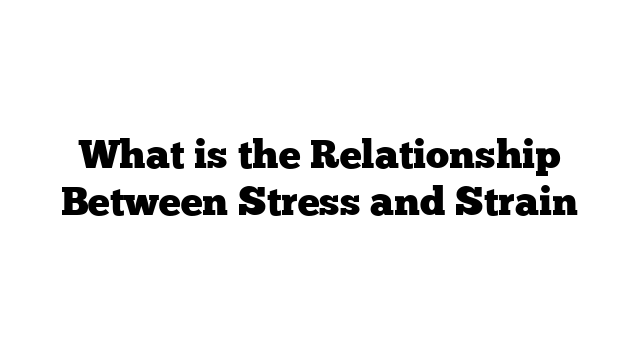Introduction
Stress and strain are fundamental concepts in the field of physics that describe the behavior of materials when subjected to external forces. Understanding the relationship between stress and strain is crucial in various fields, including engineering, material science, and biomechanics. In this article, we will explore the definition of stress and strain, discuss Hooke’s Law, and delve into the relationship between stress and strain.
Definition of Stress and Strain
In simple terms, stress is defined as the force per unit area acting on an object, while strain refers to the amount of relative deformation caused by the force applied to an object. Stress is typically denoted by the symbol σ, and its SI unit is Pascal (Pa), which is equivalent to N/m^2. On the other hand, strain is denoted by the symbol ɛ and is dimensionless.
Hooke’s Law
Hooke’s Law is a principle that explains the relationship between stress and strain in an elastic material. According to Hooke’s Law, the strain in a solid is directly proportional to the applied stress, as long as the material remains within its elastic limit. This means that the material will return to its original shape and size once the external forces are removed.
The Stress-Strain Curve
To better understand the relationship between stress and strain, we can examine the stress-strain curve. A stress-strain curve is a graphical representation of the stress and its corresponding strain values for a particular material. It provides valuable information about the material’s mechanical properties and behavior under different loads.
The stress-strain curve typically consists of several regions: the elastic region, the plastic region, and the fracture region. Let’s focus on the elastic region, as it is directly related to the relationship between stress and strain.
Elastic Region
In the elastic region of the stress-strain curve, the material behaves linearly, following Hooke’s Law. This means that the stress and strain are directly proportional to each other. As the applied stress increases, the material undergoes deformation, resulting in an increase in strain.
Within the elastic region, the relationship between stress and strain can be expressed as:
σ = Eɛ
Where σ is the stress, E is the Young’s modulus (a measure of the material’s stiffness), and ɛ is the strain. The Young’s modulus represents the slope of the stress-strain curve in the elastic region.
The elastic limit is the maximum stress that a material can withstand without experiencing permanent deformation. If the stress exceeds the elastic limit, the material enters the plastic region, where it undergoes permanent deformation.
Importance of Understanding the Relationship Between Stress and Strain
Understanding the relationship between stress and strain is crucial in various fields and applications. Here are a few reasons why it is important:
1. Material Selection and Design: Engineers and designers need to understand how different materials behave under different loads to select the most suitable material for a particular application. The stress-strain relationship helps determine the material’s strength, stiffness, and ability to withstand external forces.
2. Structural Analysis: In structural analysis, the relationship between stress and strain is used to assess the structural integrity and stability of buildings, bridges, and other structures. By analyzing the stress-strain behavior, engineers can ensure that structures can withstand expected loads without failure.
3. Biomechanics: In the field of biomechanics, understanding the stress-strain relationship is crucial for studying the behavior of biological tissues such as muscles, bones, and ligaments. This knowledge helps researchers develop prosthetics, implants, and rehabilitation techniques.
4. Material Testing: The stress-strain relationship is used in material testing to determine the mechanical properties of materials. By subjecting materials to controlled loading conditions, engineers can obtain stress-strain data to evaluate their performance and suitability for specific applications.
Conclusion
In conclusion, the relationship between stress and strain is essential in understanding the behavior of materials under external forces. Hooke’s Law provides a framework for this relationship, stating that stress and strain are directly proportional within the elastic limit. The stress-strain curve further illustrates this relationship, allowing engineers and scientists to analyze and predict material behavior. By understanding this relationship, we can make informed decisions in material selection, design, structural analysis, and biomechanics.
